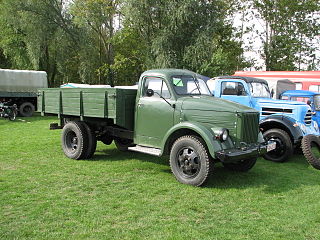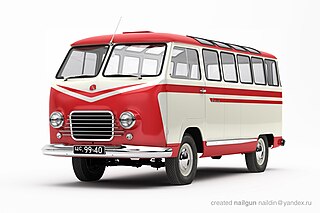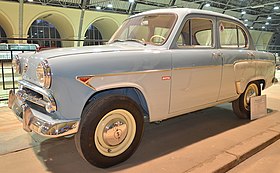Design
The styling of the Moskvitch-402 followed the fashion set by similar-sized cars of its time such as the Hillman Minx, FIAT 1100, Ford Prefect 100E, Jowett Javelin, and Ford Consul Mk1, [1] as well as by the larger GAZ-21 Volga, whose designers took part in the creation of this car. [2] The M-402 was the first Moskvitch designed in the Soviet Union and not based on any foreign model. [3] It utilized a 35 hp (26 kW ; 35 PS )1,222 cc (74.6 cu in) inline four-cylinder flathead engine derived from the 1,074 cc (65.5 cu in) of its predecessors. [1] The top speed was 88–90 kilometres per hour (55–56 mph), a slight increase over the M-401 series, mostly due to considerable reductions in body weight; it could achieve 9 L/100 km (26 mpg‑US; 31 mpg‑imp). In 1958, among other changes, the engine was replaced with MZMA's OHV development, which allowed the car to obtain a maximum speed increase up to 115 kilometres per hour (71 mph) and significantly reduced the level of noise. At 4,055 mm (159.6 in) overall, it was 200 mm (7.9 in) longer than the 401. [1] Though the gearchange had moved to the steering column, the gearbox was the same three-speed manual. [4] Electrics changed from six volt to twelve, [1] a change already being made in the United States. Radio, cigarette lighter, and demister were standard, at a time when the demister was not so in the United Kingdom. [1]
The estate (402-423) appeared in 1957, with folding rear seats and a 250 kg (550 lb) payload. [4] Proposed three-door and sedan delivery models were not produced. [4]
Exported to several Western countries, the M-402 in Norway had an advantage over the Ford Anglia or Prefect, being both more available and less subject to import duty. [4]
Limited production of four-wheel drive variants of the M-402 (the M-410 saloon) was built in 1957-1958, using transfer case and axles of the GAZ-69 and Pobeda steering. [4] Its performance was good: ground clearance was the same as that of the GAZ-69, 220 mm (8.7 in); it could cross water 300 mm (12 in) deep; climb a 33° slope; and reach 56 kilometres per hour (35 mph). [4]
The final Moskvitch-402 was produced in July 1957; there were 94,080 in all (including 18,019 for export). [5]
M-407
With the new M-407-series 45 hp (34 kW ; 46 PS )1,358 cc (82.9 cu in) overhead valve engine, in 1958, the M-402 became the Moskvitch-407. [6] A four-speed transmission with synchromesh appeared in December 1959, in place of the three-speed. [7]
Also, there was a more powerful version of 407, delivering 67 hp, that could reach up to 145 km/h, reaching 100 km/h in about 19 seconds. This model was only for the soviet Police and KGB, not for sales to public. These performances were about the same with the M-412, launched about 8 years later. Some were sold to public when withdrawn from regular Police service.
The M-407 was offered as an estate (407-423N), delivery (407-430), medical team model (407B), and taxi (407T). [5] The delivery simply had the rear windows of the estate not cut out and the rear doors welded shut; it was only available to official groups. [5]
A M-407 came third in class at the 1000 Lakes Rally in 1957. [5]
Like the M-402, there were four-wheel drive M-407s, too, beginning with the M-407-410N in June 1958 and the M-407-411N estate in August. [7] At first, these had the three-speed, changing to the four-speed in 1960. [7] A total of 11,890 four-wheel drive 402s and 407s were built by the end of production in January 1961, [7] a result of Moskvitch being unable to keep up with demand for its mainstream M-407s. [8]
In 1961, the M-407 was further upgraded with an even more powerful M-407D1-D2 engine (allowing to handle the fourth speed on a manual transmission), self-adjusting brake cylinders and hydraulic clutch drive, improved front suspension for easier driving, [9] and a completely restructured dashboard. This model, manufactured as the Moskvitch 403, served as a transition between the second and the third generation Moskvitches, debuting in 1964, with the mechanical components of the Moskvitch 408 (which had not yet appeared) and the body of the M-402. [10] The M-403E and M-403IE were intended for export. [10] In 1963, an estate variant, the 424, appeared (with the 424E the export model). [10] The M-403 lasted only until July 1965, with 133,523 cars built (50,612 for export). [10]
The M-402 was discontinued by August 1959, with the M-407 production ending in October 1963 (with 359,980 built, 120,903 for export). [9]
The M-407 was the first Soviet automotive export to be truly successful in the West. [8] Up to half of all M-407 production was exported for a number of years, mainly to the Eastern Bloc countries, Norway, Finland, and France. [8] In parts of Western Europe, it was rebranded the Elite, to avoid conflict with Peugeot, which had trademarked names with middle "0"s. [8] A large number of the cars sold in Western Europe were assembled by Sobimpex (known as Scaldia from 1965) in Seneffe, Belgium. Owned by a Romanian-born Belgian, Joseph Beherman, Scaldia was the first to assemble Soviet automobiles within the EEC. [11] To keep up with Western standards of speed and fuel economy, Beherman also offered a Perkins 4.99 diesel engine of 1.6 litre and 43 hp (32 kW), which was only slightly slower than the petrol-engined model but considerably more economical. The cars received Belgian tires, while Deluxe models were fitted with European-made interiors and chrome brightwork. Test production began in 1962, with full series production commencing in March 1964. [11] Production was of the M-407 and M-423, even though the newer M-403 had arrived in some markets.
The Moskvitch-402 and 407 could be considered as the first step in Soviet and Russian automotive history towards producing customer-adapted trim levels for various uses. While the M-407 provided greater driving comfort at bigger expenses, other trim levels included the M-407-424 station wagon available for the general public, M-431 delivery pick-up/ambulance van and even the 410/411 attempt of creating an SUV-based sedan/station wagon.

Moskvitch or Moskvich is a Soviet/Russian automobile brand produced by AZLK from 1946 to 1991 and by OAO Moskvitch from 1991 to 2001 and later returned to production in 2022. The current article incorporates information about both the brand and the joint-stock successor of AZLK.

The Opel Kadett is a small family car produced by the German automobile manufacturer Opel from 1936 until 1940 and then from 1962 until 1991, when it was succeeded by the Opel Astra.

The Lada / VAZ-2105, 2104 and 2107, collectively marketed as Lada Riva for right-hand drive models, the Lada Nova in Germany, and by multiple other names and markets, are a series of compact sedans of the Zhiguli line-up, built by Russian car manufacturer AvtoVAZ. Introduced in 1979 in the Soviet Union, and progressively introduced to Western European and global markets from the early 1980s, under the Lada brand, they were sold as saloons, and station wagon (2104) versions.

The GAZ-51 was a Soviet truck manufactured by GAZ. Its first prototypes were produced before the end of World War II and had been influenced by the Studebaker US6. The mass production started in 1946.

FSO Warszawa is an automobile manufactured in FSO factory in Warsaw, Poland between 1951–1973, based on GAZ-M20 Pobeda.
AZLK is a Soviet and Russian automobile manufacturer (Moscow), the maker of the Moskvitch brand.

The Volga is an executive car that originated in the Soviet Union to replace the GAZ Pobeda in 1956. Their role in serving the Soviet nomenklatura made them a contemporary cultural icon. Several generations of the car have been produced.

The GAZ-M20 "Pobeda" is a passenger car produced in the Soviet Union by GAZ from 1946 until 1958. It was also licensed to the Polish Passenger Automobile Factory and produced there as the FSO Warszawa. Although usually known as the GAZ-M20, an original car's designation at that time was just M-20: M for "Molotovets".

LuAZ was a Ukrainian automobile manufacturer in the city of Lutsk built in the Soviet Union. Since 2009 it has been known as Bogdan Motors Automobile Assembly Plant No. 1.

The Moskvitch 400-420 is a car that was introduced in 1947 by the Soviet manufacturer Moskvitch.

The Moskvitch 410 was an experimentally designed limited production car made by Soviet manufacturer MZMA from 1957 to 1961. Initially conceived as an economical and comfortable means of transport for agricultural machines' repairing teams, the 410 presented itself as a four wheel drive version of the Moskvitch 402 with a more powerful engine and higher ground clearance. In 1958, however, MZMA produced an upgraded station wagon variant on the same wheelbase, called Moskvitch 411. In total, only 7580 of model 410 and 1515 of model 411 were made.

The Moskvitch-408 series is a small family car produced by the Soviet car manufacturer MZMA/AZLK between 1964 and 1975. The first prototype was made in 1960.

The Moskvitch 412 is a small family car produced by Soviet/Russian manufacturer MZMA/AZLK in Moscow from 1967 to 1975, and by IZh in Izhevsk from 1967 to 1982. It was a more powerful and prestigious version of the M-408 model, offering more features for a higher price.

The Moskvitch 2140 series is a small family car produced by Soviet automotive maker AZLK from January 1976 to 1988. It started first as Moskvitch 2138 and Moskvitch 2140 on a modified 412 platform. Pre-production models were shown during 1975. Starting in 1981, the modernised modification of the M-2140 export/luxury model was also designed and branded "2140 SL" in the Eastern Bloc countries and "1500 SL" outside. The most notable differences between the two models were redesigned dashboard and front seat headrests in the M-2140.

The ZIL-4104 was a limousine built by ZIL from the late 1970s to the early 1980s, when it served as the transport of the elite of the Soviet Union. It is estimated that no more than fifty cars were produced each year.

The GAZ-24 "Volga" is a car manufactured by the Gorky Automobile Plant from 1970 to 1985 as a generation of its Volga marque. A largely redesigned version – GAZ-24-10 – was produced from 1985 to 1992. The Belgian-assembled rebadged models were sold as Scaldia-Volga M24 and M24D for the Western European market.

The GAZ M21 Volga is an automobile produced in the Soviet Union by GAZ from 1956 to 1970. The first car to carry the Volga name, it was developed in the early 1950s. Volgas were built with high ground clearance, rugged suspension, strong and forgiving engine, and rustproofing on a scale unheard of in the 1950s.

The RAF-977 was a Soviet cabover van made by Riga Autobus Factory (RAF) based on components from the GAZ-21 Volga. It was introduced in 1958 and was manufactured in two main styles: a 10-seater minibus and an ambulance. In 1961, an updated version called the RAF-977D was put into production; this had a one-piece windshield, instead of the split, and Volga steering wheel among its other detail changes. Variants included the 977I ambulance and a special Intourist model, which had better seats, roof lights, and sunroof.
Bulgaria's production strongly depended on auto imports from the Soviet block earlier and currently depends on other European and Asian countries. Presently, Bulgaria introduced its own domestic supercar company, SIN Cars and armed automobiles SAMARM.





















